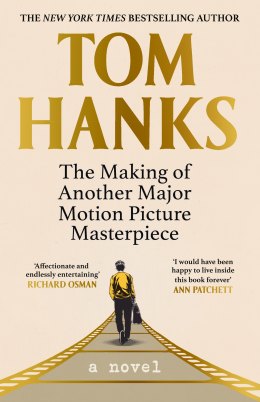By Brian McFarlane
FICTION
The Making of Another Major Motion Picture Masterpiece
Tom Hanks
Hutchinson Heinemann, $32.99
Tom Hanks is one of the most interesting actors of the past several decades, seeming less glossy film star and more actor and human being. As well as being prolific – with about 90 acting (and producer) credits– he is also very versatile (think of his two most recent roles, as A Man Called Otto and as Colonel Parker in Elvis). Now, he must add “novelist” to his daunting CV, as under the above – and oddly – named title, the cover announces “a novel”.

Tom Hanks, aka Tom Hanks the novelist, with feline friend in A Man Called Otto.Credit:
However, this is far from being a conventional novel in which character, event and (sometimes) ideas interact in a cause-and-effect way that lead the reader to a satisfying closure. Novelists as far back as James Joyce or as recent as William Boyd have shown that the deployment of the usual ingredients is not obligatory, and the title of Hanks’ first novel immediately suggests something different, and that is what we get.
What shapes the book is, on one level, the way it relates the key stages in the making of a film, starting from “Backstory”, with a grasp of how its complex procedures involve a shifting gaggle of people whose functions and dealings with each other contribute to the rich texture of the novel. Real-life names (say, John Wayne) and footnotes (not overdone, and as fictional in their content as the matter to which they refer) remind us of other literary and cinematic works while it embeds itself in its own stylistic achievement of a faux realism.

Credit:
The section headings (“chapters” would be too usual) are all intended to announce the stages involved in the making of the film, moving from “Source Material”, to “Casting” and “The Shoot” and others. The procedures involved no doubt mirror such actualities as Hanks himself would know, but they also provide a grasp of the lives so involved, of what it is like to be one of the film-making hierarchy and of how the position reached in the latter can draw on and shape individual lives.
Here, director Bill Johnson wants to make a superhero movie derived from an underground comic book. This latter was in turn the work of a World War II veteran’s nephew who has turned his uncle’s story after many years into Heroes under Fire and later still Knightshade: The Lathe of Firefall. When you learn that the comic books are all written by Hanks (and illustrated by Robert Sikoryak), you realise how strange a piece of fiction his first novel is.
But the actual content of the films is less the source of the book’s ongoing absorption than the processes of production of what Johnson hopes will become a franchise success. Among these processes, the casting and location are endlessly entertaining.
For instance, the heroine is to be played by household name Wren Lane (real name Wendy Lank), a film star with male problems and for whom – as is wittily noted – flying a plane keeps her grounded. Not grounded enough to deal with OKB (Bailey), the egomaniac co-star who is responsible for the disastrous first-day footage and will shortly be sacked by the director, and replaced by Ike Clipper, who bonds rather more closely with Wren than his wife Thea cares for.
And so on. There is ahuge cast of characters in the book and film, but Hanks imbues them all with touches of individuality, whether they are actors, including an elderly one called Elliott who dies on the shoot, forceful assistant producer Ms Al Mac-Teer, make-up artist Kenny Sheprock – and so on. They are all seen in relation to their functions in the film-making progress, so that, numerous as they are, they aren’t allowed to clutter the narrative and are often charged with wit. As when author/screenwriter Robby, who writes as Trev-vorr, is “ragged on [by his sister} with his fancy nom-de-pencil”.
There isn’t space, and not really any need, to go into detail about the plot of the film in the making, but how JB deals with cast and crew over the period of the shoot keeps us occupied to the end. There is also a sense of cultural changes over the decades between Robby’s post-WWII childhood and his reunion with the uncle, as well as over the locations in which these lives are set.
Perhaps only an actor as experienced as Hanks could have commanded such an account of how an industry works: an opening claim says “based on a true story”, but is it? Or is this another witty hit at what any movie – or novel – can make of what pass as facts? I hope Hanks won’t give up acting, but if he ever tires of it he can have a new career as imaginative novelist.
Brian McFarlane’s most recent book, The Films of Fred Schepisi, is published by University Press of Mississsippi.
The Booklist is a weekly newsletter for book lovers from books editor Jason Steger. Get it delivered every Friday.